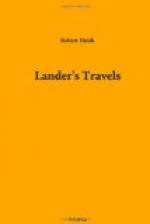Sockna stands on an immense plain of gravel, bounded to the south by the Soudah mountains, at about fifteen miles; by the mountains of Wadam, about thirty miles to the eastward; a distant range to the west, and those already mentioned on the north. The town is walled, and may contain two thousand persons. There are small projections from the walls, having loop-holes for musketry. It has seven gates, only one of which will admit a loaded camel. The streets are very narrow, and the houses are built of mud and small stones mixed, many of them having a story above the ground-floor. A small court is open in the centre, and the doors, which open from this area, give the only light which the rooms receive. The water of Sockna is almost all brackish or bitter. There are 200,000 date trees in the immediate neighbourhood of the town, which pay duty; also an equal number, not yet come into bearing, which are exempt. These dates grow in a belt of sand, at about two or three miles distant from the town, and are of a quality far superior to any produced in the north of Africa. Owing to their excellence, they are sold at a very high price at Tripoli. The adjoining country is entirely destitute of shrubs, or any kind of food for camels, which are therefore sent to graze about five miles off; while in the town, all animals are fed on dates. Sheep are brought here from Benioleed, and are, in consequence of coming from such a distance, very dear. In the gardens about three miles from the town, barley, maize, and gussob ohourra are cultivated, as well as a few onions, turnips, and peppers. The number of flies here are immense, and all the people carry little flappers, made of bunches of wild bulls’ hair tied to a short stick, in order to keep those pests at a distance. The dates all being deposited in store-houses in the town, may account in some degree for the multitude of these insects, which in a few minutes fill every dish or bowl containing any liquid.
The costume is here the same as that of the Bedouins, consisting generally of a shirt and barracan, a red cap, and sandals. A few, whose circumstances allow of it, dress in the costume of Tripoli. The neat appearance of the men in general is very striking, compared with that of the Arabs about the coast. The women are considered exceedingly handsome, indeed one or two were really so, and as fair as Europeans, but they are noted for their profligacy and love of intrigue.




